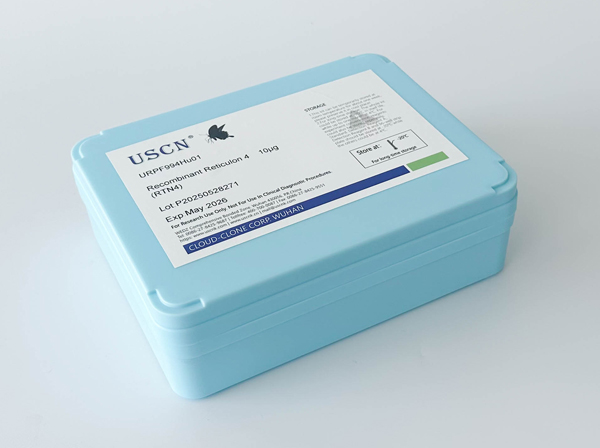Active Cathepsin D (CTSD)
CPSD; CLN10; Lysosomal Aspartyl Protease; Ceroid-Lipofuscinosis,Neuronal 10
- Product No.UAPB280Hu61
- Organism SpeciesHomo sapiens (Human) Same name, Different species.
- Buffer FormulationPBS, pH7.4, containing 0.01% SKL, 1mM DTT, 5% Trehalose and Proclin300.
- TraitsFreeze-dried powder
- Purity> 97%
- Isoelectric Point6.1
- ApplicationsCell culture; Activity Assays.
- Download Instruction Manual
- UOM 10µg50µg 200µg 1mg 5mg
-
FOB
US$ 168
For more details, please contact local distributors!US$ 420
For more details, please contact local distributors! US$ 840
For more details, please contact local distributors! US$ 2520
For more details, please contact local distributors! US$ 6300
For more details, please contact local distributors!
ACTIVITY TEST of the Active Cathepsin D (CTSD)

Figure. The binding activity of CTSD with HSP90b1.
Cathepsin D (CSTD) is an aspartic protease that depends critically on protonation of its active site Asp residue. Along with Asp-protonation, lower pH also leads to conformational switch in cathepsin-D: the N-terminal segment of the protease moves out of the active site as pH drops. Similar to other aspartic protainases, cathepsin D accommodates up to 8 amino acid residues in the binding cleft of the active site. The main physiological functions of cathepsin D consist of metabolic degradation of intracellular proteins, activation and degradation of polypeptide hormones and growth factors, activation of enzymatic precursors, processing of enzyme activators and inhibitors, brain antigen processing and regulation of programmed cell death. Besides, Heat Shock Protein 90kDa Beta 1 (HSP90b1) has been identified as an interactor of CSTD, thus a binding ELISA assay was conducted to detect the interaction of recombinant human CSTD and recombinant human HSP90b1. Briefly, CSTD were diluted serially in PBS, with 0.01% BSA (pH 7.4). Duplicate samples of 100μL were then transferred to HSP90b1-coated microtiter wells and incubated for 2h at 37℃. Wells were washed with PBST and incubated for 1h with anti-CSTD pAb, then aspirated and washed 3 times. After incubation with HRP labelled secondary antibody, wells were aspirated and washed 3 times. With the addition of substrate solution, wells were incubated 15-25 minutes at 37℃. Finally, add 50µL stop solution to the wells and read at 450nm immediately. The binding activity of CSTD and HSP90b1 was shown in Figure 1, and this effect was in a dose dependent manner.
USAGE of the Active Cathepsin D (CTSD)
Reconstitute in 20mM Tris, 150mM NaCl (PH8.0) to a concentration of 0.1-1.0 mg/mL. Do not vortex.
STORAGE of the Active Cathepsin D (CTSD)
Avoid repeated freeze/thaw cycles. Store at 2-8°C for one month. Aliquot and store at -80°C for 12 months.
STABILITY of the Active Cathepsin D (CTSD)
The thermal stability is described by the loss rate. The loss rate was determined by accelerated thermal degradation test, that is, incubate the protein at 37°C for 48h, and no obvious degradation and precipitation were observed. The loss rate is less than 5% within the expiration date under appropriate storage condition.
INCREMENT SERVICES
BCA Protein Quantification Kit
Molecular Mass Marker for Protein
Monoclonal Antibody Customized Service
Polyclonal Antibody Customized Service
Protein Activity Test Experiment Service
Electrophoretic Mobility Shift Assay (EMSA) Experiment Service
Buffer
Lentivirus Packaging Experiment Service
Adenovirus Packaging Experiment Service
Real Time PCR Experimental Service
Spike RBD Protein (S-RBD)
Protein G
Protein A
Related products
| Catalog No. | Organism species: Homo sapiens (Human) | Applications (RESEARCH USE ONLY!) |
| UAPB280Hu61 | Active Cathepsin D (CTSD) | Cell culture; Activity Assays. |
| UEPB280Hu61 | Eukaryotic Cathepsin D (CTSD) | Positive Control; Immunogen; SDS-PAGE; WB. |
| URPB280Hu01 | Recombinant Cathepsin D (CTSD) | Positive Control; Immunogen; SDS-PAGE; WB. |
| UAPB280Hu62 | Active Cathepsin D (CTSD) | Cell culture; Activity Assays. |
| UEPB280Hu62 | Eukaryotic Cathepsin D (CTSD) | Positive Control; Immunogen; SDS-PAGE; WB. |
| URPB280Hu02 | Recombinant Cathepsin D (CTSD) | Positive Control; Immunogen; SDS-PAGE; WB. |
| URPB280Hu03 | Recombinant Cathepsin D (CTSD) | Positive Control; Immunogen; SDS-PAGE; WB. |
| URPB280Hu04 | Recombinant Cathepsin D (CTSD) | Positive Control; Immunogen; SDS-PAGE; WB. |
| UPAB280Hu02 | Polyclonal Antibody to Cathepsin D (CTSD) | IHC; ICC/IF |
| UPAB280Hu01 | Polyclonal Antibody to Cathepsin D (CTSD) | WB; IHC |
| ULAB280Hu71 | Biotin-Linked Polyclonal Antibody to Cathepsin D (CTSD) | WB; IHC; ICC. |
| UMAB280Hu21 | Monoclonal Antibody to Cathepsin D (CTSD) | ICC/IF |
| UMAB280Hu26 | Monoclonal Antibody to Cathepsin D (CTSD) | WB |
| UMAB280Hu22 | Monoclonal Antibody to Cathepsin D (CTSD) | WB; IHC; ICC/IF |
| UFAB280Hu02 | Anti-Cathepsin D (CTSD) Monoclonal Antibody | Flow cytometry. |
| USEB280Hu | ELISA Kit for Cathepsin D (CTSD) | Enzyme-linked immunosorbent assay for Antigen Detection. |
| UHEB280Hu | High Sensitive ELISA Kit for Cathepsin D (CTSD) | Enzyme-linked immunosorbent assay for Antigen Detection. |
| ULMB280Hu | Multiplex Assay Kit for Cathepsin D (CTSD) ,etc. by FLIA (Flow Luminescence Immunoassay) | FLIA Kit for Antigen Detection. |



